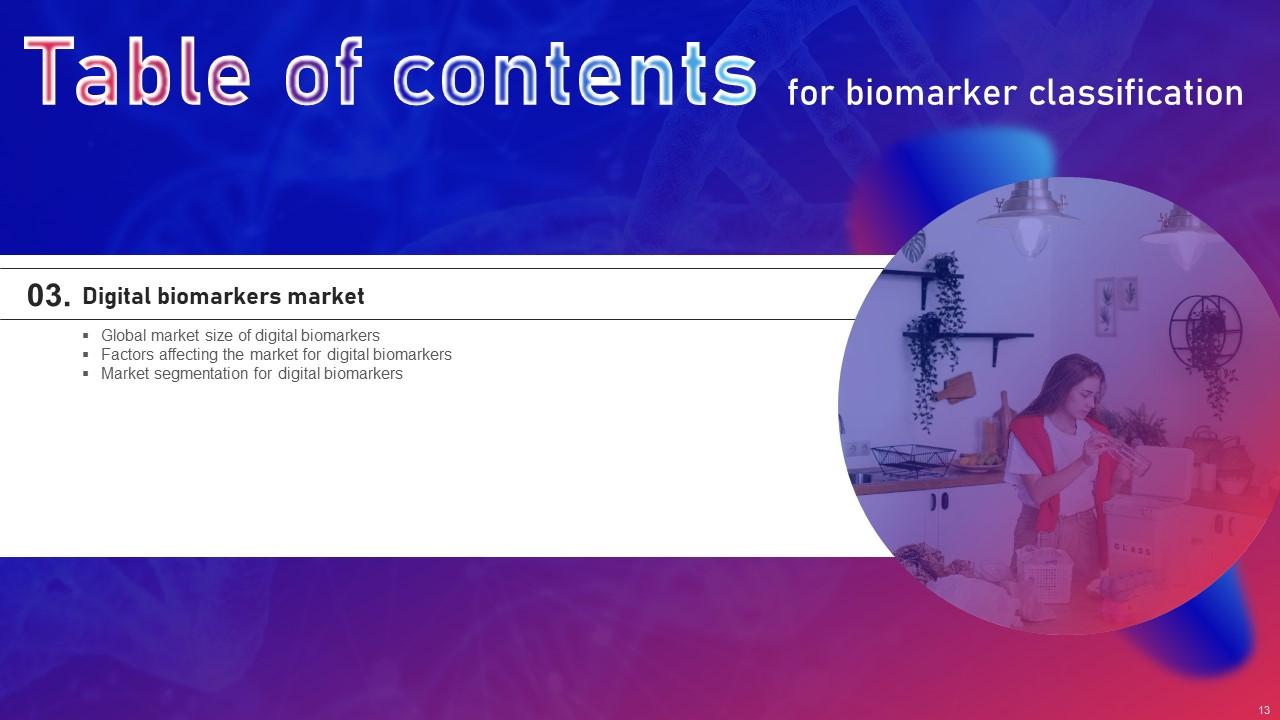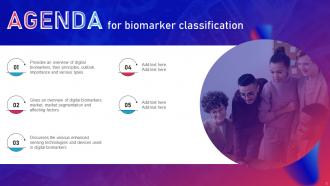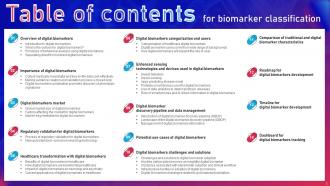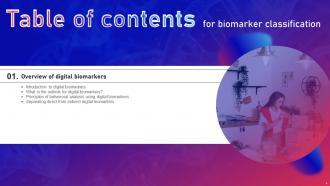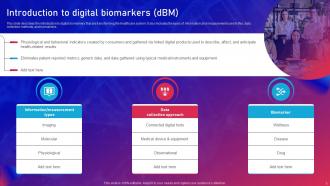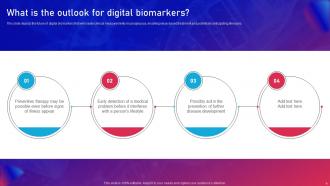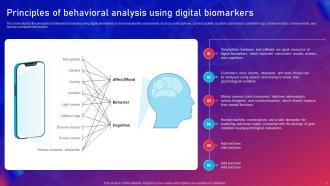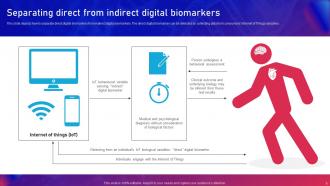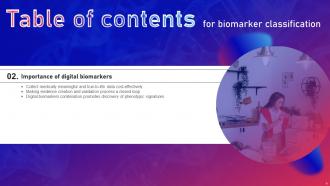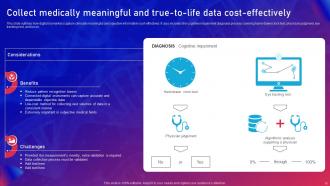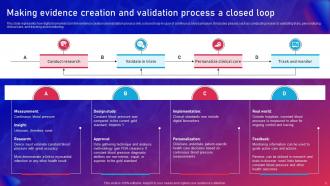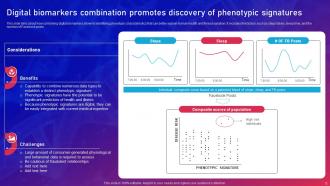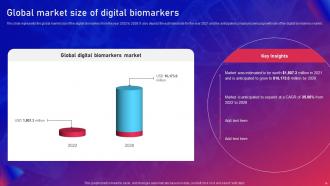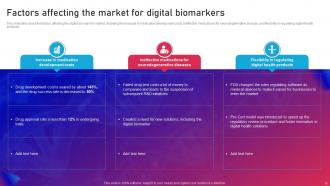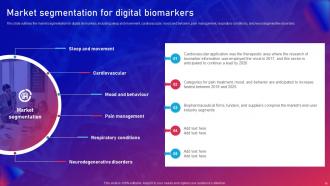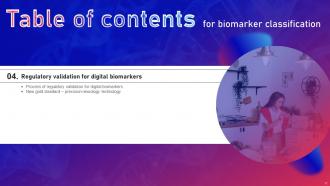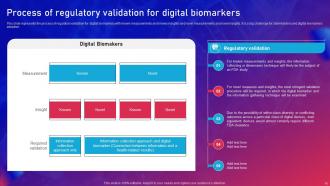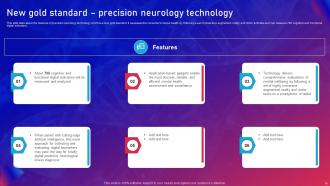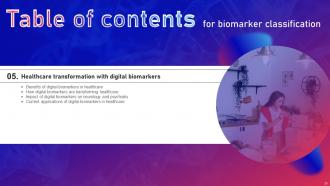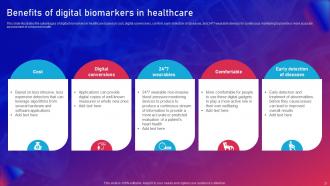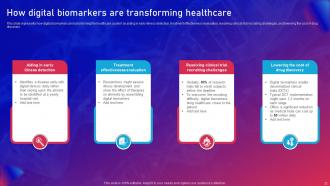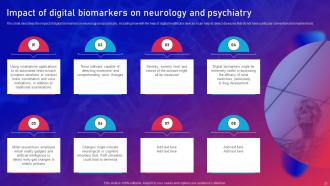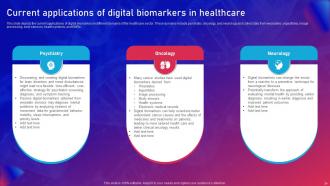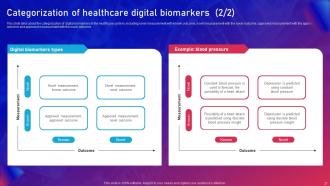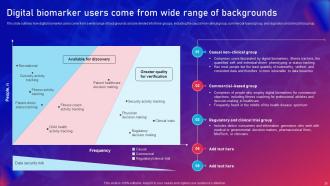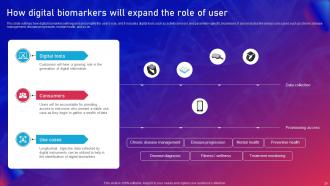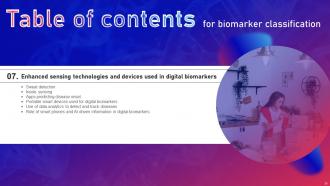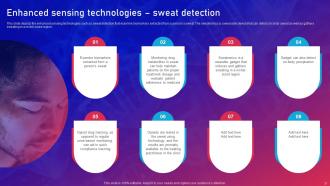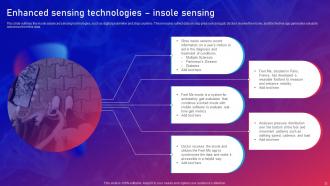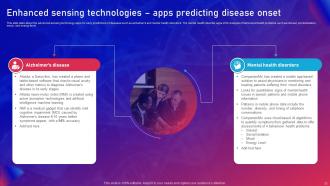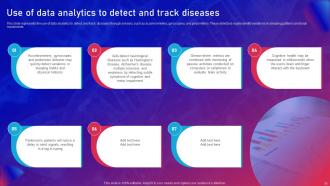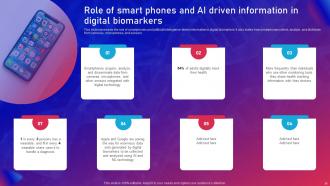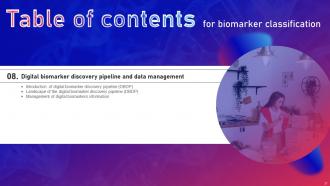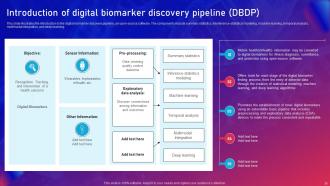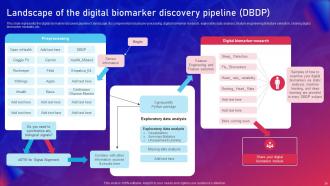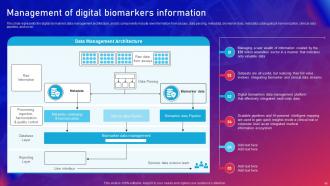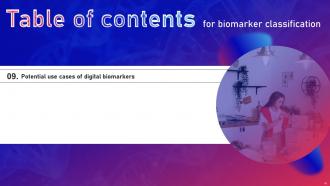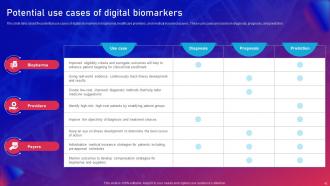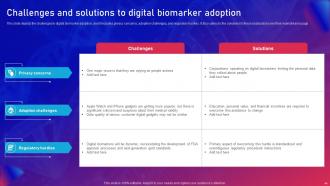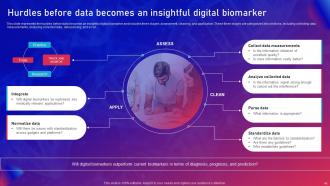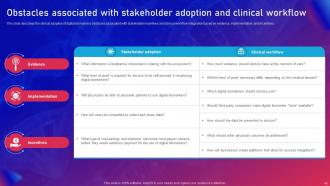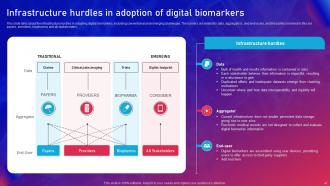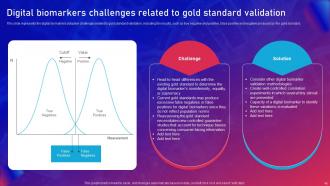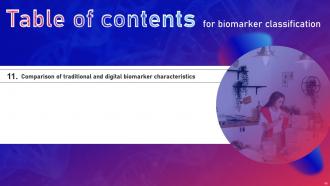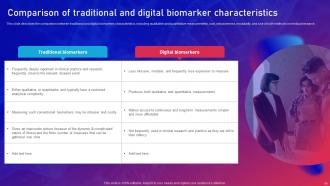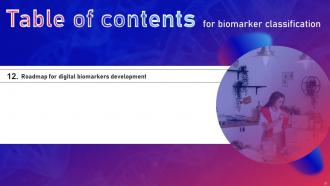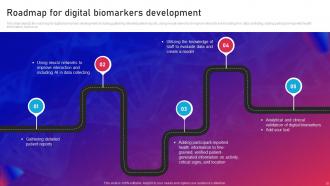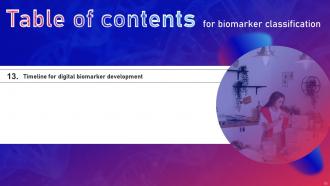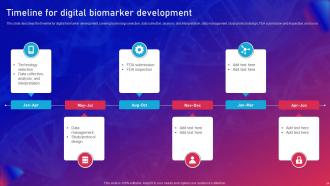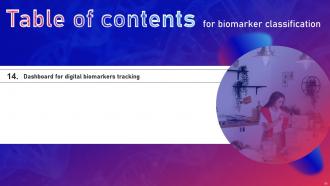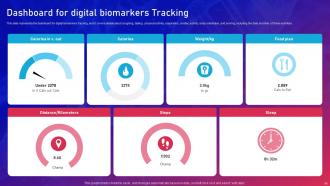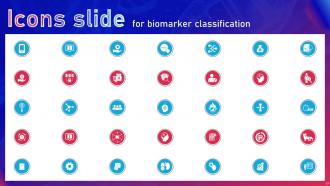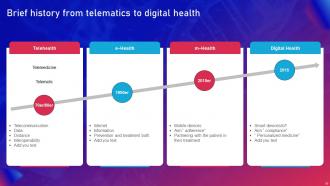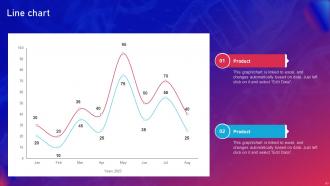Biomarker Classification IT Powerpoint Presentation Slides
Immerse yourself in the world of biomarkers with our insightful and expertly designed Biomarker Classification template. This comprehensive presentation provides a concise yet comprehensive overview of digital biomarkers, their significance, market outlook, regulatory validation processes, and more. Our Biomarker Classification deck begins with an overview of digital biomarkers, exploring their relevance and the principles of behavioral analysis. It highlights the importance of digital biomarkers in healthcare and delves into their classification, including a detailed analysis of the global market size, market factors, and segmentation. Our Digital Health PPT also covers the regulatory validation processes associated with digital biomarkers. Additionally, it showcases the transformative impact of digital technology in healthcare, presenting its benefits and application areas. Further, our Biomedical Informatics module categorizes digital biomarkers and identifies their users. Our Biomedical Informatics template reveals various enhanced sensing devices used in digital biomarkers, like sweat detection, insole sensing, disease onset prediction apps, etc. It also addresses potential use cases, challenges, and solutions related to adopting digital biomarkers. Lastly, the PPT exhibits a roadmap, a timeline for developing digital biomarker solutions, and a performance-tracking dashboard. Get instant access.
You must be logged in to download this presentation.
PowerPoint presentation slides
Enthrall your audience with this Biomarker Classification IT Powerpoint Presentation Slides. Increase your presentation threshold by deploying this well-crafted template. It acts as a great communication tool due to its well-researched content. It also contains stylized icons, graphics, visuals etc, which make it an immediate attention-grabber. Comprising sixty six slides, this complete deck is all you need to get noticed. All the slides and their content can be altered to suit your unique business setting. Not only that, other components and graphics can also be modified to add personal touches to this prefabricated set.
People who downloaded this PowerPoint presentation also viewed the following :
Content of this Powerpoint Presentation
Slide 1: This slide introduces BIOMARKER Classification (IT). Commence by stating Your Company Name.
Slide 2: This slide depicts the Agenda of the presentation.
Slide 3: This slide includes the Table of contents.
Slide 4: This slide highlights the Title for the Topics to be covered further.
Slide 5: This slide describes the introduction to digital biomarkers that are transforming the healthcare system.
Slide 6: This slide depicts the future of digital biomarkers.
Slide 7: This slide reveals the principles of behavioral analysis using digital biomarkers.
Slide 8: This slide portrays how to separate direct digital biomarkers from indirect digital biomarkers.
Slide 9: This slide includes the Heading for the Contents to be discussed in the upcoming template.
Slide 10: This slide outlines how digital biomarkers capture clinically meaningful and objective information cost-effectively.
Slide 11: This slide represents how digital biomarkers turn the evidence creation and validation process into a closed loop in case of continuous blood pressure.
Slide 12: This slide talks about how combining digital biomarkers allow for identifying phenotypic characteristics.
Slide 13: This slide states the Title for the Ideas to be covered in the upcoming template.
Slide 14: This slide represents the global market size of the digital biomarkers from the year 2022 to 2028.
Slide 15: This slide talks about the factors affecting the digital biomarkers market.
Slide 16: This slide outlines the market segmentation for digital biomarkers.
Slide 17: This slide shows the Heading for the Ideas to be discussed next.
Slide 18: This slide represents the process of regulatory validation for digital biomarkers with known measurements.
Slide 19: This slide talks about the features of precision neurology technology which is a new gold standard.
Slide 20: This slide mentions the Title for the Contents to be covered further.
Slide 21: This slide illustrates the advantages of digital biomarkers in healthcare.
Slide 22: This slide presents how digital biomarkers are transforming the healthcare system.
Slide 23: This slide highlights the Impact of digital biomarkers on neurology and psychiatry.
Slide 24: This slide depicts the current applications of digital biomarkers in different domains of the healthcare sector.
Slide 25: This slide displays the Heading for the Topics to be discussed in the upcoming template.
Slide 26: This slide represents the categorization of digital biomarkers in the healthcare system.
Slide 27: This slide talks about the categorization of digital biomarkers in the healthcare system.
Slide 28: This slide outlines how digital biomarker users come from a wide range of backgrounds.
Slide 29: This slide reveals how digital biomarkers will expand and amplify the user's role.
Slide 30: This slide presents the Title for the Topics to be covered in the next template.
Slide 31: This slide depicts the enhanced sensing technologies.
Slide 32: This slide outlines the insole advanced sensing technologies.
Slide 33: This slide talks about the advanced sensing technology apps for early predictions of diseases.
Slide 34: This slide depicts the portable devices used for digital biomarkers and some major players in the industry.
Slide 35: This slide represents the use of data analytics to detect and track diseases through sensors.
Slide 36: This slide shows the role of smartphones and artificial intelligence-driven information in digital biomarkers.
Slide 37: This slide exhibits the Heading for the Contents to be discussed further.
Slide 38: This slide illustrates the introduction to the digital biomarker discovery pipeline, an open-source software.
Slide 39: This slide represents the digital biomarker discovery pipeline's landscape.
Slide 40: This slide portrays the digital biomarkers data management architecture.
Slide 41: This slide displays the Title for the Ideas to be further covered.
Slide 42: This slide talks about the potential use cases of digital biomarkers.
Slide 43: This slide includes the Heading for the Ideas to be covered next.
Slide 44: This slide depicts the challenges to digital biomarker adoption.
Slide 45: This slide represents the hurdles before data becomes an insightful digital biomarker.
Slide 46: This slide describes the clinical adoption of digital biomarkers obstacles associated with stakeholder incentives.
Slide 47: This slide talks about the infrastructure hurdles in adopting digital biomarkers, including conventional and emerging challenges.
Slide 48: This slide presents the digital biomarkers adoption challenges related to gold standard validation.
Slide 49: This slide displays the Title for the Contents to be further discussed.
Slide 50: This slide describes the comparison between traditional and digital biomarkers characteristics.
Slide 51: This slide contains the Heading for the Topics to be covered in the following template.
Slide 52: This slide depicts the roadmap for digital biomarkers development.
Slide 53: This slide displays the Title for the Topics to be discussed next.
Slide 54: This slide describes the timeline for digital biomarker development.
Slide 55: This slide indicates the Heading for the Contents to be covered in the following template.
Slide 56: This slide represents the dashboard for digital biomarkers tracking.
Slide 57: This is the Icons slide containing all the Icons used in the plan.
Slide 58: This slide is used for depicting some Additional information.
Slide 59: This slide presents the Brief history from telematics to digital health.
Slide 60: This slide elucidates the organization's Targets.
Slide 61: This slide shows the Line chart of the company.
Slide 62: This is the Puzzle slide with related imagery.
Slide 63: This slide contains the Post it notes for reminders and deadlines.
Slide 64: This is the 30 60 90 days plan slide for effective planning.
Slide 65: This slide displays the Venn diagram.
Slide 66: This is the Thank you slide for acknowledgement.
Biomarker Classification IT Powerpoint Presentation Slides with all 71 slides:
Use our Biomarker Classification IT Powerpoint Presentation Slides to effectively help you save your valuable time. They are readymade to fit into any presentation structure.
FAQs
Digital biomarkers are objective, quantifiable measures obtained from digital devices and sensors that provide clinically meaningful information about an individual's health and well-being. They can be used to monitor and track various physiological, behavioral, and environmental parameters.
Digital biomarkers are transforming the healthcare system by enabling continuous monitoring of patients, providing real-time and objective data for diagnosis and treatment decisions, improving disease management and personalized care, and facilitating remote patient monitoring and telemedicine.
Digital biomarkers can be categorized into physiological biomarkers (e.g., heart rate, blood pressure), behavioral biomarkers (e.g., sleep patterns, activity levels), and environmental biomarkers (e.g., air quality, noise levels) based on the parameters they measure.
The advantages of digital biomarkers in healthcare include cost-effectiveness, continuous monitoring, real-time data collection, early detection of diseases, personalized treatment plans, improved patient engagement, and enhanced research and development capabilities.
Some challenges to adopting digital biomarkers include stakeholder incentives, data management and privacy concerns, regulatory and validation requirements, integration with existing healthcare systems, infrastructure limitations, and the need for standardized protocols and interoperability.
-
The content is very helpful from business point of view.
-
Fantastic collection of visually appealing PowerPoint templates. They certainly uplift the look of the presentation.














